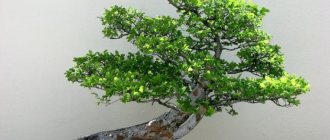Author: Elena N. https://floristics.info/ru/index.php?option=com_contact&view=contact&id=19 Category: Garden plants Published: December 12, 2018Last edits: November 04, 2020
- Growing conditions
- Hemp sapling (Eupatorium cannabinus)
Pokonnik (lat. Eupatorium) is a genus of perennials of the Asteraceae, or Asteraceae, family, originating from North America and widespread in Asia, Europe and tropical regions of Africa. The genus includes more than 120 described species, but more than 200 more species of sapwood have an uncertain status. The Russian name of the plant most likely comes from the word “poskon”, as the male hemp plant is called, with which poskon has some external resemblance, and the genus received its scientific name in honor of Mithridates Eupator, the Pontic king, who used one of the plant species as antidotes.
Description
Purple sapling (lat. Eupatorium purpureum) is a perennial herbaceous shrub. It belongs to the Asteraceae, or Asteraceae, family. Found in the wild in Europe, Asia, and America. “Poskonnik” received its modern name for its resemblance to hemp, which in Rus' was previously called “poskon”.
Purple sapling - a modest handsome man
The main parameters of purple sapling are presented in the table:
| Parameter | Meaning |
| Russian names-synonyms | Hemp, turnip, horse's mane, sedach, shaposhnik |
| Plant type | Herbaceous perennial shrub |
| General form | Dense, heavily leafy, medium-spreading bush up to 2 m high and up to 1 m wide, over time can form continuous thickets |
| Escapes | Erect, non-branching, powerful, red-violet |
| Leaves | Opposite or whorled, elongated spear-shaped, slightly boat-curved, bright green with reddish-purple veins, edge of the plate slightly serrated, petiole short |
| Root system | Well developed rhizome |
| Flowers | Pink-lilac, small, with a tubular corolla, collected in inflorescences-baskets, forming voluminous caps up to 30 cm in diameter at the ends of the shoots |
| Fruit | Small, dark, rough, located in seed pods |
Flowering period
Purple sapling blooms in mid-summer. At this time, the plant emits a subtle, pleasant aroma that attracts many butterflies and other insects. Flowering lasts about 7 weeks and usually ends in September, although individual specimens may continue to bloom until the first frost.
Varieties
Poskonnik at the dacha
The window sill is the “king” of autumn. When other flower crops begin to lose their decorative value, it only reveals itself in all its glory. The plant cannot yet boast of great diversity.
The variety most often found on sale is Little Red - a relatively compact (80-90 cm) representative of the family, pleasing with its bright crimson color.
So far, Eupatorium is only gaining popularity among gardeners, so the main work of breeders is still ahead. Moreover, the family has over 120 varieties. In Russia, in addition to purple, you can find the following window sills:
- Wrinkly. Pale yellow inflorescences framed by bluish foliage, very similar to nettles. The bush is quite loose, tends to collapse, and therefore needs support. The Chocolate variety looks the most impressive: dark stems with snow-white flowers.
- Hemp. The most common species in the wild. It grows mainly along the banks of water bodies and wetlands. Tall, large, with strong branches. Due to the numerous bright bracts, the corollas are mistaken for double ones.
- Spotted. Most of the decorative varieties of Eupatorium are of this species. A distinctive feature is the longitudinal strokes on the stems.
- Tubular. The window sill is a giant three-meter high. A fragrant specimen that blooms from August until frost.
However, you should know that absolutely all representatives of this family are poisonous.
Growing from seeds
In the wild, purple sapling reproduces by self-sowing, which is why the plant eventually forms dense thickets. The seed method can also be used for growing seedlings and then planting them on the site. However, if you plant sapling seeds directly in open ground, the grown plants will bloom only in the 3rd year. Therefore, it is recommended to use the seedling method.
Seed preparation
Before sowing planting material, it must be stratified for 1 month. It is better to do this in February-March. Purple sapling seeds are mixed with sand and placed in the refrigerator for this period, where they are stored in a vegetable tray at a temperature of about + 2 °C.
When to plant
At the end of stratification, the seeds of purple sapling are sown in containers filled with special soil. The optimal time for this is the last ten days of March. By this time, you need to prepare wide and shallow containers for growing seedlings, and also stock up on soil, purchasing it in a store or mixing sand, peat and turf soil in equal proportions yourself.
It is very convenient to use special cups or cassettes for growing seedlings
Important! Before use, the soil must be disinfected by spilling it with a solution of potassium permanganate or calcining it in the oven for at least 0.5 hours at a temperature of + 200 ° C.
How to grow seedlings
Stratified seeds of purple sapling are kept for 1 day in a weak solution of potassium permanganate, and then planted in containers filled with soil without being buried. The planting material is evenly distributed over the surface, lightly pressed down or sprinkled with a thin layer of soil, and then moistened with water from a spray bottle. The container is covered with glass or film and then placed in a warm, dark place.
Important! Periodically, the cover must be removed to ventilate the soil. In case of drying out, it is moistened with warm, settled water.
It takes 2 to 3 weeks for purpurea seeds to germinate
Purple sapling seeds germinate in 2-3 weeks. After the first shoots appear, the cover should be removed and the container moved to a well-lit place. After 2 pairs of permanent leaves appear, the seedlings are picked into separate pots. It will remain there until the end of May; it is at this time that it is transplanted into open ground. Approximately 10-14 days before this, the containers begin to be exposed to air, and the holding time is increased each time. This is how plants are hardened.
Important! The soil temperature at the time of transplanting seedlings should not be lower than + 8-10 ° C, there should be no threat of return frosts.
Planting in open ground
Purple sapling is undemanding to growing conditions. The procedure for planting it is simple, as is its subsequent care.
How to choose a place
Purple sapling has no special preferences, it does not place high demands on the site and grows well both in the sun and in partial shade. The soil is preferably fertile and loose; this plant does not feel comfortable on clay and sand. Acidity should be close to neutral.
How to prepare the soil
Before planting young seedlings of the purple sapling, the soil on the site should be dug up, cleared of debris and old grass, and at the same time add compost (3-5 kg per 1 sq. m). Planting holes are prepared based on the size of the seedling's root system. When planting in groups, the intervals between neighboring plants should be at least 0.6 m. The seedlings are removed from the cup along with a lump of earth on the roots and carefully placed in a hole, sprinkled with earth and compacted. After this, the young seedling must be watered abundantly.
Peat cups eliminate the need to remove the plant before planting
Important! If you immediately use peat cups for growing seedlings, then no picking is done, and planting in open ground is done together with the container, without removing the plant.
Watering
Purple sapling loves moist soil, but excess water is harmful to it. Excessive moisture can lead to rotting of the roots and death of the plant, so watering is required, although regular, but moderate. Newly planted seedlings, as well as separated parts of rhizomes that are in the process of rooting, need additional watering. At such times, you need to be especially careful to ensure that the soil does not dry out.
Feeding
Frequent regular fertilizing of purple saplings is not required. In early spring, nitrogen fertilizers are applied, stimulating the growth of shoots, and during the period of budding and flowering, you can use any complexes for flowering shrubs, for example, Kemira-Universal.
Do I need to tie it up?
The stems of the purple sapling are strong and rigid; they can easily withstand the weight of a large, cap-shaped inflorescence. The bushes themselves are also quite dense and resist the wind well. Therefore, there is no need to tie them up.
Features of plant care
The window sill needs moisture, so it needs to be watered abundantly and often. It is recommended to make at least three fertilizings per season (with complex mineral fertilizers): in spring, early summer and during the budding phase.
The sapling shrub may also need to be tied to a support. Pruning to form a bush is not necessary, but it is still recommended to trim off faded inflorescences. The flower is frost-resistant, so it does not need to be covered in winter.
An important period in the life of this plant is flowering. During the period when the window sapling blooms, it needs special care.
Types of flowers:
- Little red. 100-centimeter bushes have wine-pink inflorescences;
- Little Joe. Meter-tall bushes have inflorescences consisting of small flowers of smoky pink color.
The shape of the small flowers is tubular. Baskets consisting of flowers are part of complex paniculate, corymbose or racemose inflorescences.
Flowering begins in mid-July and lasts more than a month. After flowering is completed, the plant does not lose its attractiveness.
Flowering period
Changes in care during the flowering period
The plant needs a lot of sunlight to bloom well. After the flowers begin to gain color, watering should be slightly reduced. After flowering ends, wilted inflorescences need to be trimmed.
Reproduction methods
Purple sapling can be propagated both by seeds and vegetatively. It is preferable to use the second method, since in this case all varietal characteristics of the plant are guaranteed to be preserved. In addition, when using vegetative methods, a full-fledged flowering bush can be obtained much earlier.
Dividing the bush
This propagation method is suitable for purple sapling bushes that are at least 5 years old. Its essence is as follows.
- In early spring or autumn, all shoots of the bush are cut off at a height of 0.2-0.3 m.
- The rhizome is dug out of the ground.
- Using a sharp bayonet shovel or an ax, the rhizomes are divided into parts containing several shoots with their own lobe.
- The sections are treated with a solution of potassium permanganate or brilliant green.
- The delenki are immediately planted in pre-prepared pits.
Each division must have at least 3 growth points
Important! Next time, it will be possible to divide the purple sapling bush only when it reaches the age of 5 years or more.
Young shoots
This method is similar to the previous one. For propagation, young shoots of purple sapling with a height of at least 5 cm are used, which are cut off along with the root. For growing, they are placed in special containers or boxes filled with soil for seedlings. The plants are kept in such comfortable conditions for about a month, providing them with good care and regular moderate watering. Then the strengthened seedlings of purple sapling are transplanted to a permanent place in open ground.
Cuttings
The sapling can be propagated by green cuttings, which are harvested in June. They are cut from annual shoots, the length of each should be at least 10-15 cm. Green cuttings are rooted in containers filled with a mixture of peat and sand. Planting is carried out obliquely, the depth should be about 5 cm.
Rooted cuttings should be covered with a glass jar or cut plastic bottle
A film cover must be mounted on top, or each cutting must be covered with a cut plastic bottle or glass jar. It will take about 1 month to form its own root system, after which the seedlings are transferred to a permanent place.
Important! During the entire rooting period, the cuttings of purple saplings must be ventilated and the soil substrate must be moistened, preventing it from drying out.
Photo of a window sill in landscape design
A lush purple sapling bush can be a good accent in a garden composition. In addition to individual plantings, you can also use group ones, for example, to create a hedge or a color background for smaller plants.
A two-level hedge provides excellent protection from the wind.
Purple sapling looks great as part of a mixborder
Purple sapling bushes can decorate a wrought-iron fence
Sill bushes harmoniously combine with water bodies
In combined flower beds, the window sill is planted in the background; it serves as a backdrop for other, smaller plants
Use in folk medicine
Purple sapling is included in the list of medicinal plants in Russia. It has long been used in folk medicine as an anti-inflammatory, expectorant, and diuretic. Currently, its medicinal value has been greatly lost, since much more effective drugs have been synthesized. It should also be taken into account that all parts of the purple sapling contain toxic substances - alkaloids, therefore any homemade products based on this plant should be used with caution and only after consulting a doctor.
Contraindications and side effects of the herb
Contraindications include age under 18 years, as well as any liver problems in a potential consumer. This is due to the high content of alkaloids in dry waterhemp herb, which tend to accumulate in the body and, if the concentration threshold is exceeded, can lead to hepatotoxicity.
During pregnancy (increases the risk of miscarriage due to the effect on uterine contractions) and breastfeeding, taking sap in any form is also contraindicated.
Individual intolerance serves as a direct contraindication to the use of sapling , since, as mentioned above, the chemical composition of the plant is very rich and has not been fully studied at the present stage.
Waterhemp is considered a poisonous plant; in case of overdose, nausea and vomiting immediately occur. Therefore, the best recipe to protect yourself from the side effects of the sap is a timely consultation with a qualified doctor.
The richness of its chemical composition has ensured that purple sapling has been widely used in folk and traditional medicine.











